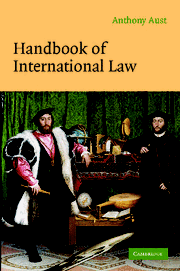Book contents
- Frontmatter
- Contents
- Foreword
- Preface
- Acknowledgments
- Table of treaties
- Table of MOUs
- Table of cases
- Glossary of legal terms
- List of abbreviations
- 1 International law
- 2 States and recognition
- 3 Territory
- 4 Jurisdiction
- 5 The law of treaties
- 6 Diplomatic privileges and immunities
- 7 State immunity
- 8 Nationality, aliens and refugees
- 9 International organisations
- 10 The United Nations, including the use of force
- 11 Human rights
- 12 The law of armed conflict (international humanitarian law)
- 13 International criminal law
- 14 Terrorism
- 15 The law of the sea
- 16 International environmental law
- 17 International civil aviation
- 18 Special regimes
- 19 International economic law
- 20 Succession of states
- 21 State responsibility
- 22 Settlement of disputes
- 23 The European Union
- Index
6 - Diplomatic privileges and immunities
Published online by Cambridge University Press: 05 August 2012
- Frontmatter
- Contents
- Foreword
- Preface
- Acknowledgments
- Table of treaties
- Table of MOUs
- Table of cases
- Glossary of legal terms
- List of abbreviations
- 1 International law
- 2 States and recognition
- 3 Territory
- 4 Jurisdiction
- 5 The law of treaties
- 6 Diplomatic privileges and immunities
- 7 State immunity
- 8 Nationality, aliens and refugees
- 9 International organisations
- 10 The United Nations, including the use of force
- 11 Human rights
- 12 The law of armed conflict (international humanitarian law)
- 13 International criminal law
- 14 Terrorism
- 15 The law of the sea
- 16 International environmental law
- 17 International civil aviation
- 18 Special regimes
- 19 International economic law
- 20 Succession of states
- 21 State responsibility
- 22 Settlement of disputes
- 23 The European Union
- Index
Summary
Never has there been such a big embassy from here … I have six pages, four dwarfs, about twenty liveried servants, who will all be splendidly dressed, five trumpeters, musicians, a pastor, surgeons, physicians and a company of well-equipped soldiers.
Denza, Diplomatic Law: Commentary on the Vienna Convention on Diplomatic Relations, 2nd edn, Oxford, 1998
Oppenheim. Oppenheim's International Law, 9th edn, London, 1992, pp. 1053–131
Satow's Guide to Diplomatic Practice, 5th edn, London, 1979
There are now 183 states parties to the Vienna Convention on Diplomatic Relations 1961 (in this chapter, ‘the Convention’). Even for the handful of non-parties, the Convention now represents an authoritative statement of the law, and as such is relied on heavily by the International Court of Justice. Nevertheless, the manner in which the Convention is interpreted and applied can vary to some degree from state to state. All members of diplomatic missions and their local legal advisers therefore need to familiarise themselves with the practice and procedures of the receiving state, which will often publish guidance.
(In this chapter, references to specific Articles are to those of the Convention, unless otherwise indicated.)
Since diplomacy is the means by which a state conducts relations with other states, the Convention plays a crucial role by regulating the establishment of permanent bilateral diplomatic missions to represent the interests of the state and the protection of its nationals, and the privileges and immunities accorded to missions and their staff to give them the necessary freedom and security to carry out their work.
- Type
- Chapter
- Information
- Handbook of International Law , pp. 117 - 158Publisher: Cambridge University PressPrint publication year: 2005



